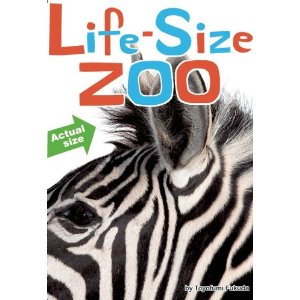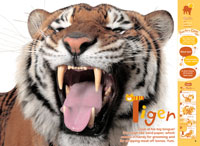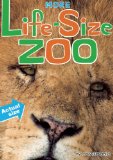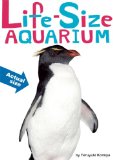 Life-Size Zoo by Teruyuki Komiya (Seven Footer Kids, 2009 for English edition) is better than a trip to the zoo. There, I said it. At least when it comes to seeing the animals up close, that is. An "actual-size animal encyclopedia," Life-Size Zoo is beautifully designed (it's a Japanese import) and illustrated with vivid color photographs of 21 zoo animals.
Life-Size Zoo by Teruyuki Komiya (Seven Footer Kids, 2009 for English edition) is better than a trip to the zoo. There, I said it. At least when it comes to seeing the animals up close, that is. An "actual-size animal encyclopedia," Life-Size Zoo is beautifully designed (it's a Japanese import) and illustrated with vivid color photographs of 21 zoo animals.
Each animal gets a double-page spread. Occasionally two animals share a spread that highlights their similarities and differences; prairie dog and meerkat, hedgehog and armadillo. There are also a couple of gatefolds (giraffe, elephant, rhinoceros) and vertical layouts: it's a very interactive book. The standard format looks like this (link is to a PDF of the tiny image below):
 Here, the right-hand column gives information about the animal in the photograph (including its name! This tiger is called Baito) and more information about what you can see in the picture ("Time for a Close-Up"), as well as facts to keep in mind when you see the animal at a zoo (note: these are often poop-related).
Here, the right-hand column gives information about the animal in the photograph (including its name! This tiger is called Baito) and more information about what you can see in the picture ("Time for a Close-Up"), as well as facts to keep in mind when you see the animal at a zoo (note: these are often poop-related).
"Time for a Close-up" is my favorite feature of Life-Size Zoo; it encourages careful looking by asking the reader to notice specific details of the photographs such as, in the case of the tiger, four huge fangs; black lips; thick whiskers on his cheeks, and a short mane all around his face. I also love the Contents, designed to look like a zoo map, and the endpapers, which include full-body snapshots of the animals in their zoo habitats. My kids like the little cartoons that illustrate the animal facts, too.

 If you like lions or prefer penguins, check out More Life-Size Zoo and Life-Size Aquarium (May and September, 2010). You might also want to compare Actual Size by Steve Jenkins (Houghton Mifflin, 2004), which is illustrated in his trademark cut and torn paper collage (there's a tiger in it, too). What's the same or different about the books' content, images, and design?
If you like lions or prefer penguins, check out More Life-Size Zoo and Life-Size Aquarium (May and September, 2010). You might also want to compare Actual Size by Steve Jenkins (Houghton Mifflin, 2004), which is illustrated in his trademark cut and torn paper collage (there's a tiger in it, too). What's the same or different about the books' content, images, and design?
[Nonfiction Monday is at the SimplyScience Blog this week. Thanks!]